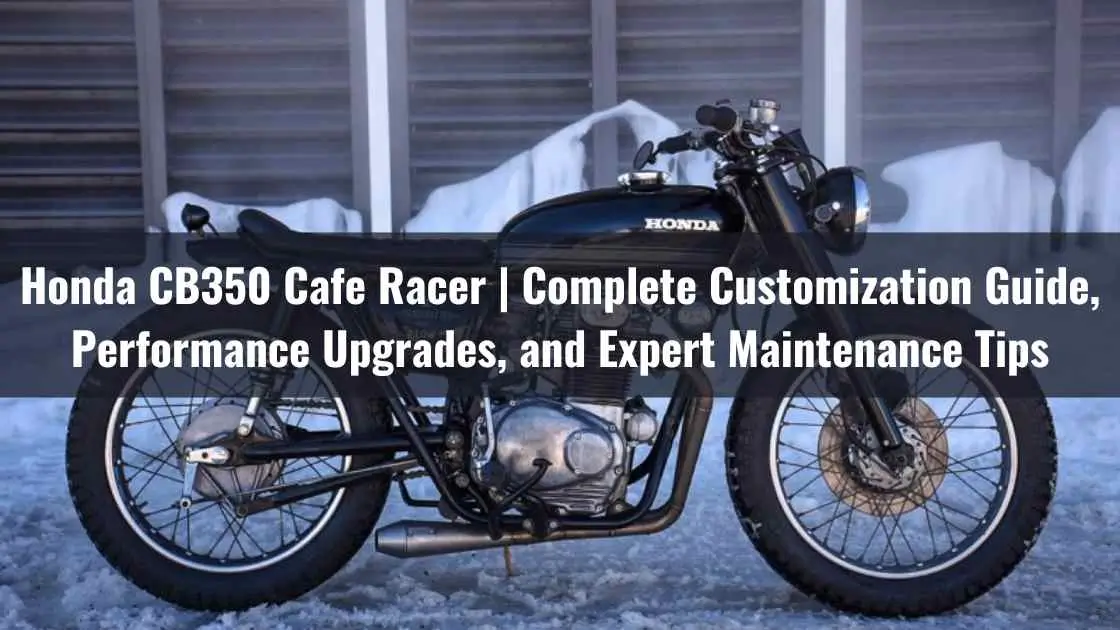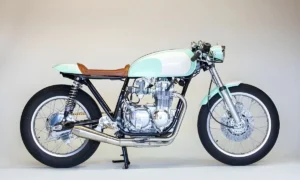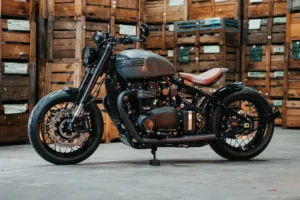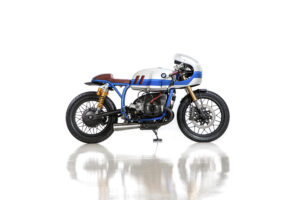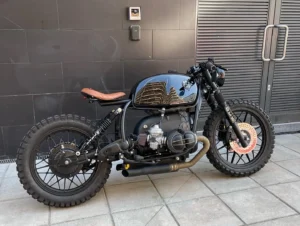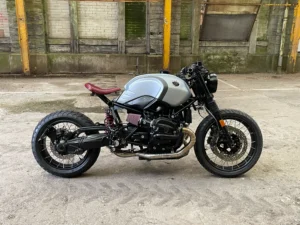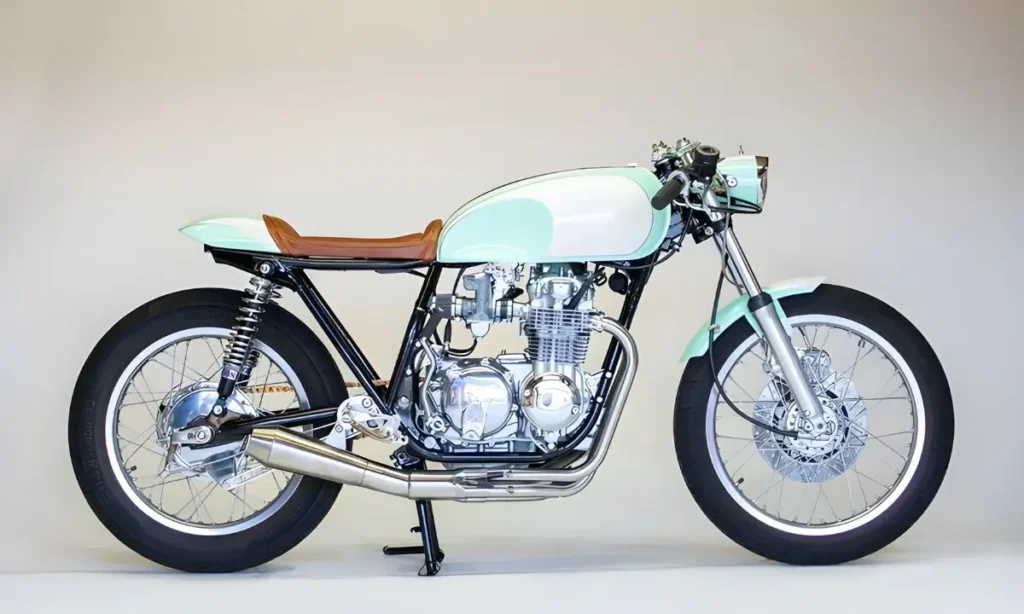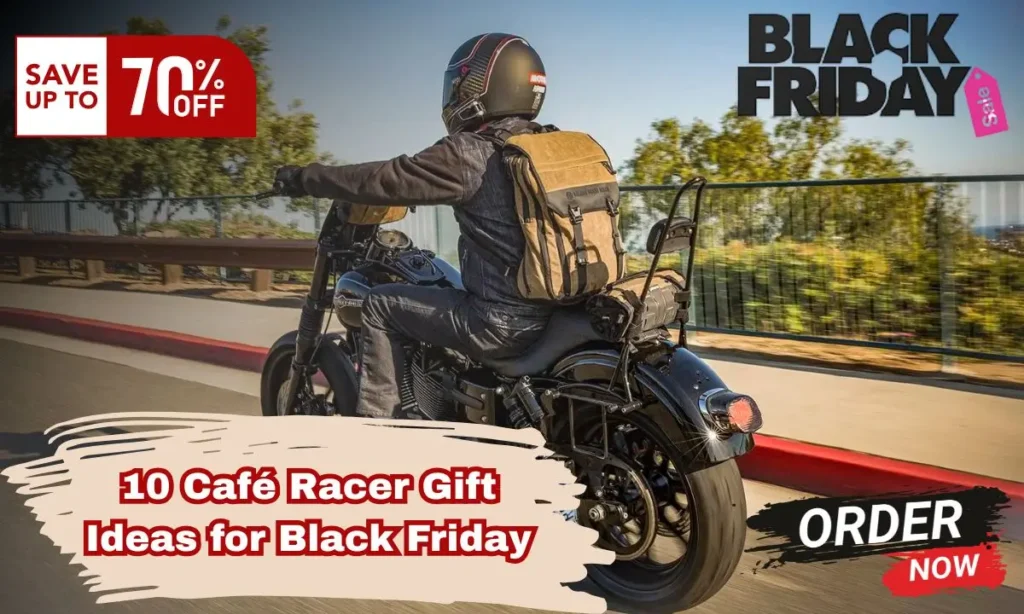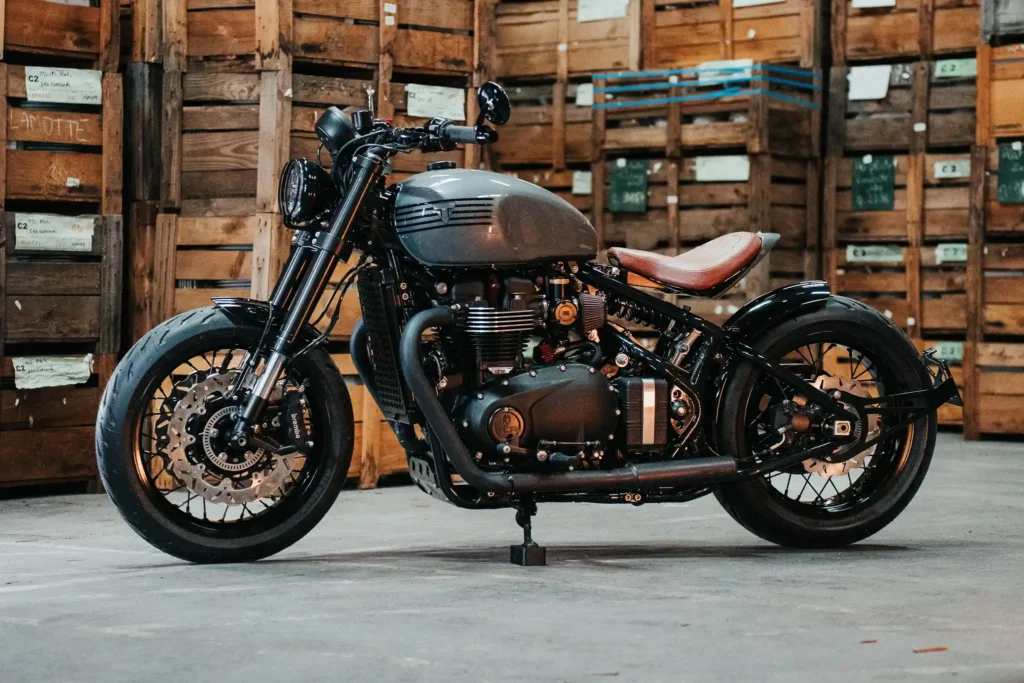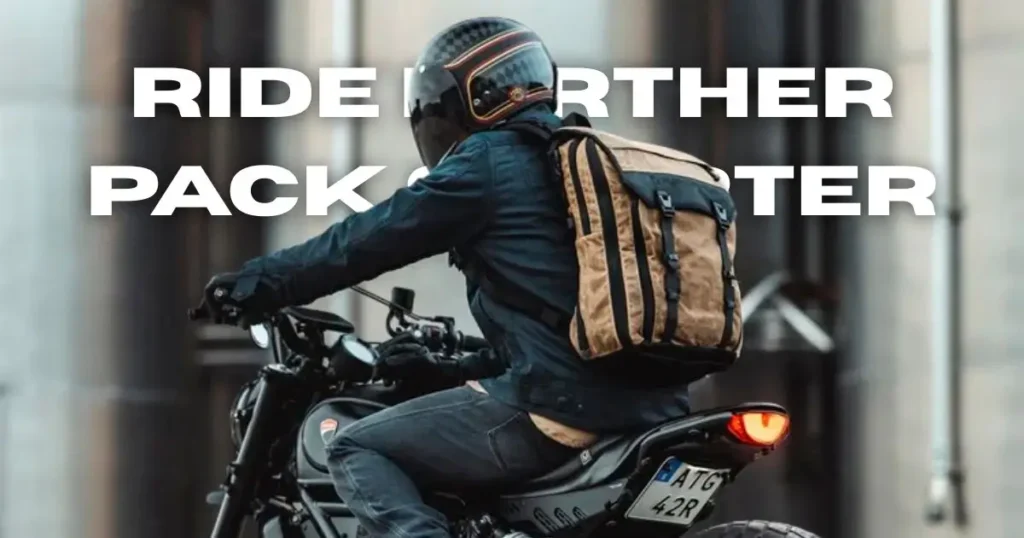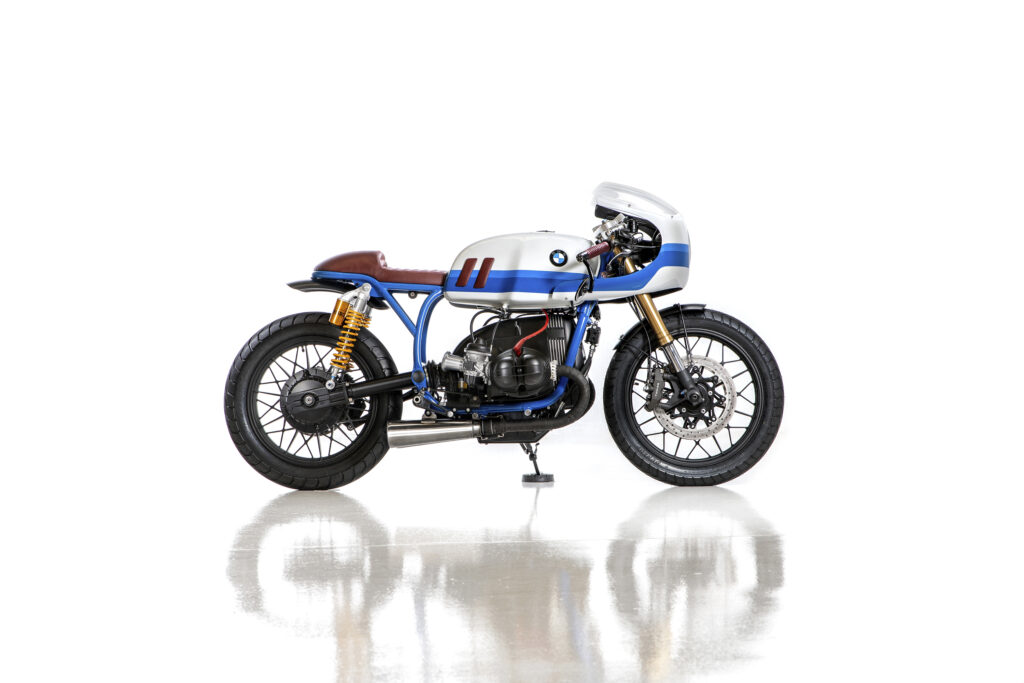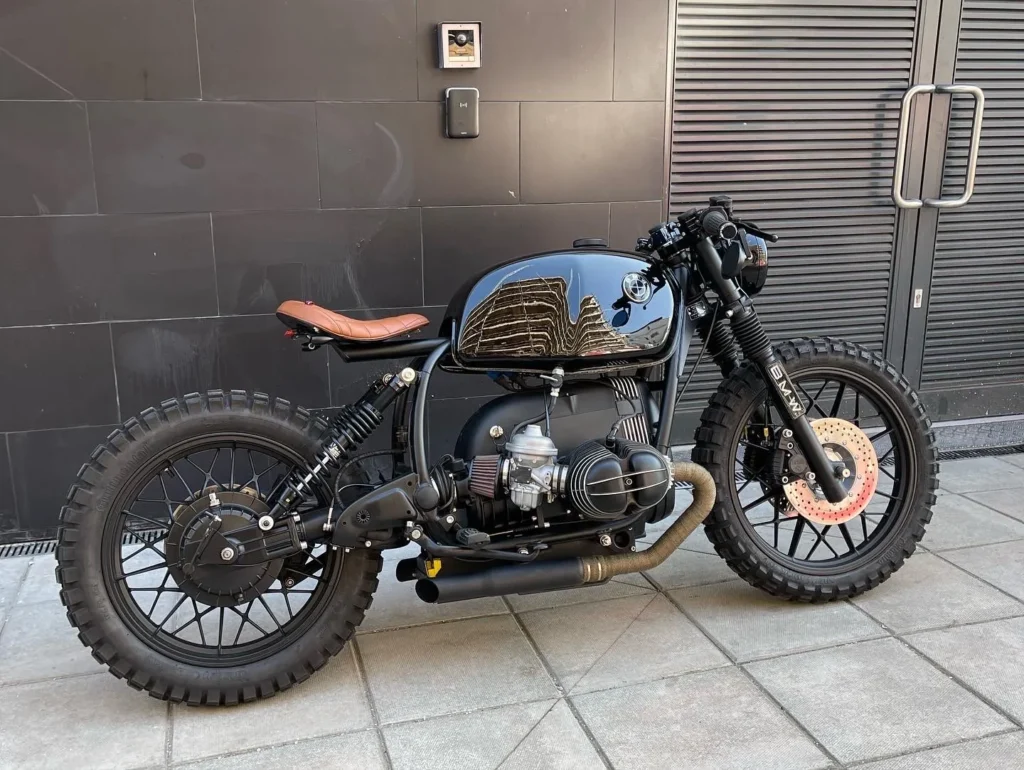Table of Contents
ToggleWhen we talk about motorcycles, one name that stands out for its classic style and ability to be customized is the Honda CB350 Cafe Racer. It’s popular because it mixes old-school charm with the ability to be changed to fit modern tastes. The Honda CB350 is a top pick in the custom bike world, especially for cafe racer fans. But what makes this bike so special? Let’s break it down in easy terms.

Overview of the Honda CB350
The Honda CB350 is a motorcycle that became very popular in the late 1960s and early 1970s. It was made from 1968 to 1973, with a 325cc parallel-twin engine that could reach a top speed of 110 mph. This bike was one of the most successful models in Honda’s CB lineup, known for its reliability, affordability, and good performance. It wasn’t the biggest or most powerful bike, but it was perfect for riders who wanted something fun to ride and easy to take care of.
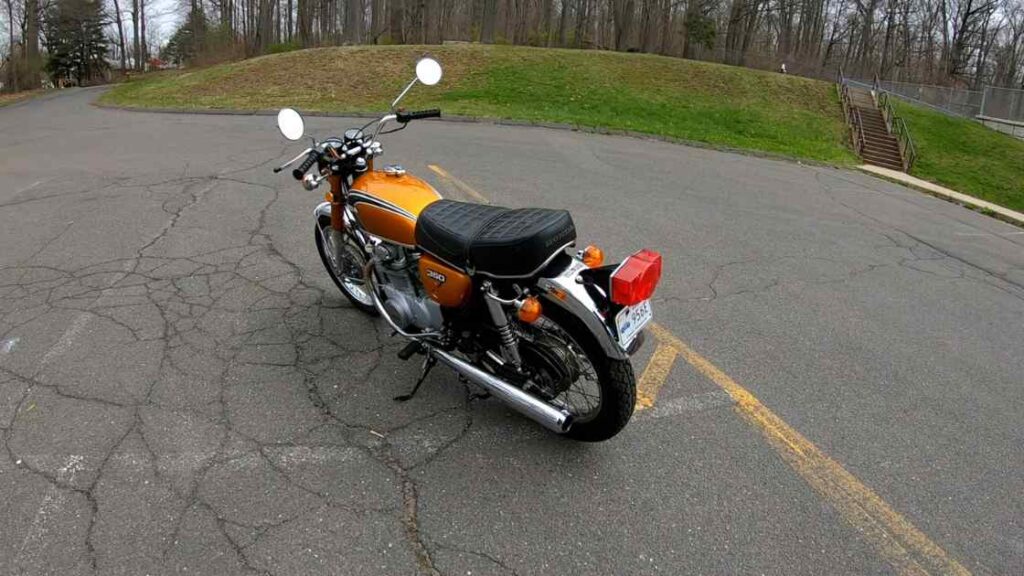
What makes the Honda CB350 stand out, even after all these years, is how flexible it is. It wasn’t just a great bike for daily rides; it also became a favorite for customization, especially in the cafe racer scene. Builders loved how they could strip down the CB350, change its frame, and turn it into a stylish, fast, and lightweight cafe racer.
Modern Versions: The Honda H’ness CB350
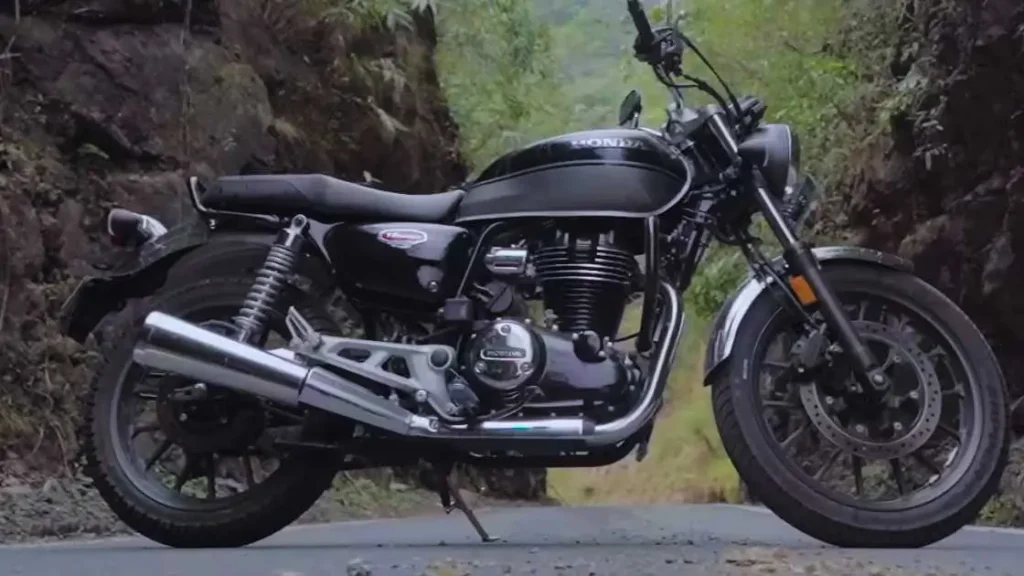
Fast forward to today, and Honda has brought back a modern version of this classic bike: the Honda H’ness CB350. Released in 2020, this new model keeps the old-school style of the original CB350 but adds modern features like ABS, LED lights, and Bluetooth. It’s a bike that mixes classic charm with today’s technology, making it a great option for turning into a cafe racer.
History of the Honda CB350
To really appreciate the Honda CB350 Cafe Racer, we need to look at the history behind this iconic motorcycle. The Honda CB350 wasn’t just any bike — it played an important role in the motorcycle world during its production years. From the late 1960s to the early 1970s, the CB350 became a favorite for riders who wanted a perfect mix of performance, reliability, and affordability.
Original CB350 (1968-1973)
The Honda CB350 was first introduced in 1968 and made until 1973. During this time, it became the best-selling model in the Honda CB series. The bike had a 325cc parallel-twin engine that made 36 horsepower, which was impressive for that period. It could reach a top speed of 110 mph, making it great for both city rides and long trips on open roads.
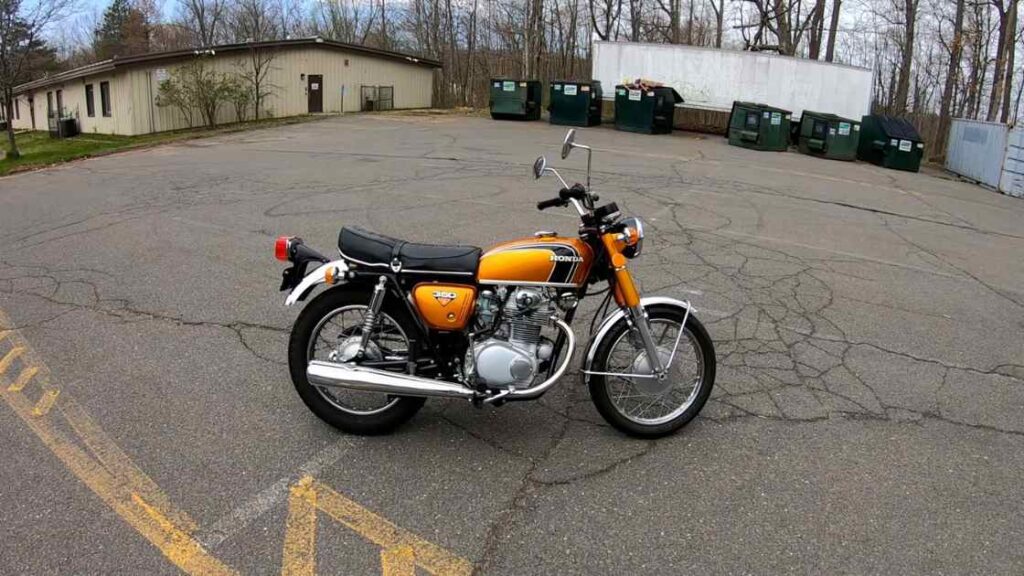
- 1972 Honda CB350
What made the CB350 stand out wasn’t just its engine power or speed, but its reliability. Honda had earned a name for making bikes that were easy to maintain and long-lasting, and the CB350 was no different. It became a top choice for everyday riders and those who wanted to customize their bikes.
For many, the CB350 was their first motorcycle. It was affordable and easy to ride, with a simple design that beginners loved. Even though it was smaller than other bikes in Honda’s lineup, it had enough power to satisfy experienced riders too.
The CB350F Four-Cylinder Version
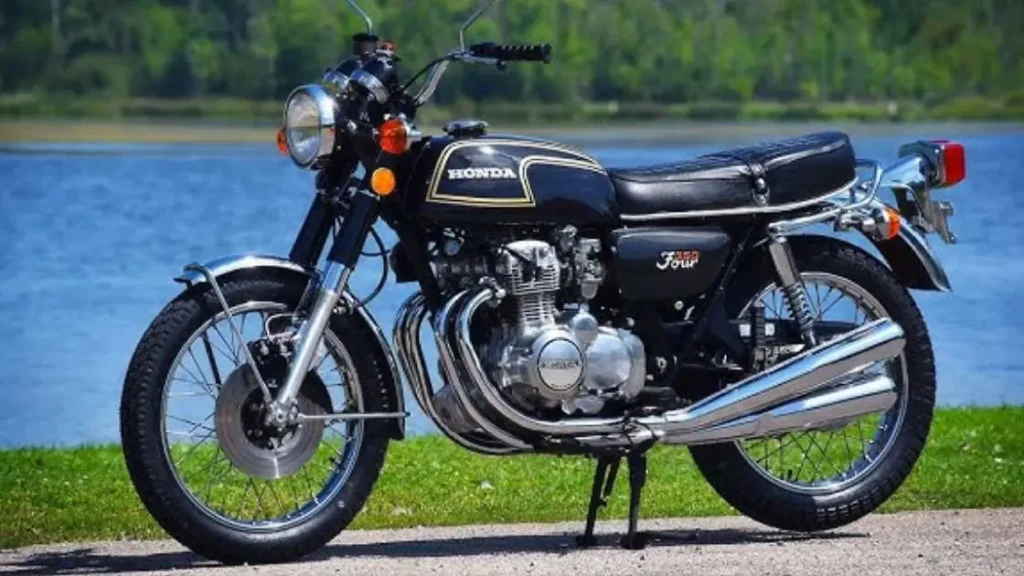
- 1974 Honda CB350-F FOUR CYLINDER
While the CB350 Twin was the most popular, there was also a rarer version: the Honda CB350F, or CB350 Four. Made between 1972 and 1974, this model had a four-cylinder engine, which was rare for such a small bike at the time. The CB350F produced 34 horsepower and could reach a top speed of 98 mph. Even though it was a bit less powerful than the twin-cylinder version, the CB350F offered a smoother ride and more advanced engineering. However, it didn’t sell as well as the twin version, which makes it a bit of a collector’s item today.
The Honda CB350 in the Custom Scene
Over the years, the Honda CB350 has become a top choice for custom builders, especially for cafe racer fans. Its lightweight frame, simple design, and reliable engine make it easy to modify. Builders often strip the bike down to its basics, removing unnecessary parts to make it lighter and faster — just what you need in a cafe racer.
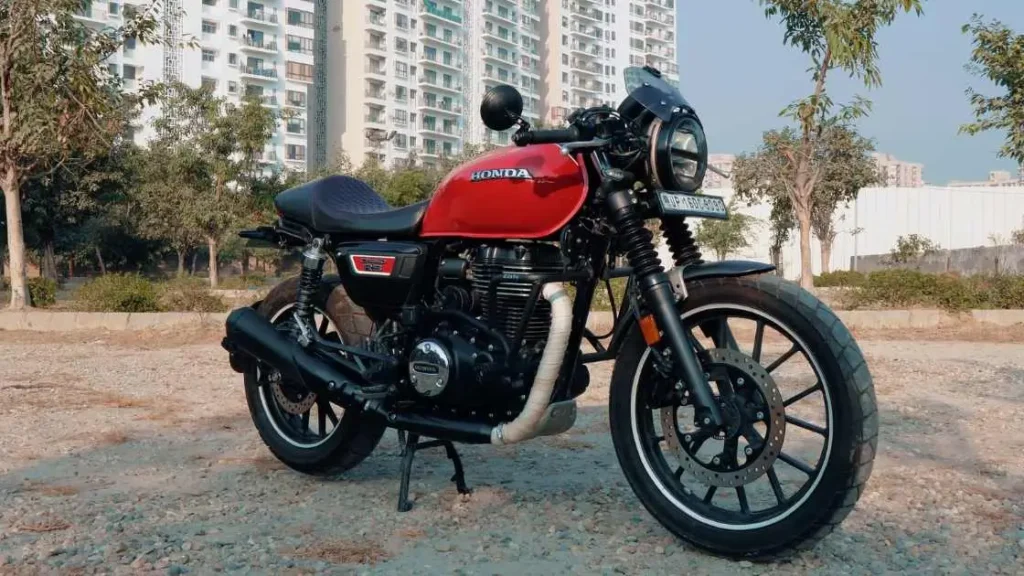
What makes the CB350 special is that it can be customized in many ways. Whether you want to build a classic cafe racer, a brat bike, or even a scrambler, the CB350 is a great base. Many builders keep the original engine but upgrade parts like the suspension, brakes, and exhaust to give it better performance while keeping its vintage style.
Honda H’ness CB350 (2020)
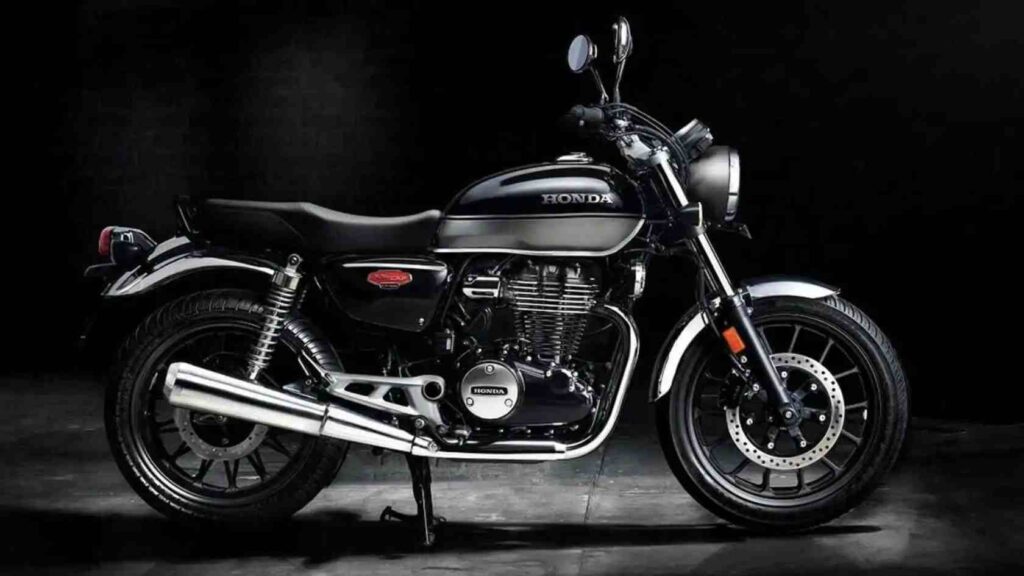
In 2020, Honda reintroduced the CB350 name with the launch of the Honda H’ness CB350. While the original CB350 was known for its simple design and affordability, the H’ness CB350 mixes that same retro style with modern features. This model has a 348cc single-cylinder engine that produces about 21 PS of power and 29.4 Nm of torque. It’s built to capture the spirit of the original CB350 while offering the comfort and technology of a modern bike.
With features like ABS, LED lighting, and Bluetooth, the H’ness CB350 gives riders a vintage look without losing modern convenience. This makes it a great choice for those who want to build a cafe racer with a mix of retro and modern style.
Key Features and Specs of the Honda CB350 Cafe Racer
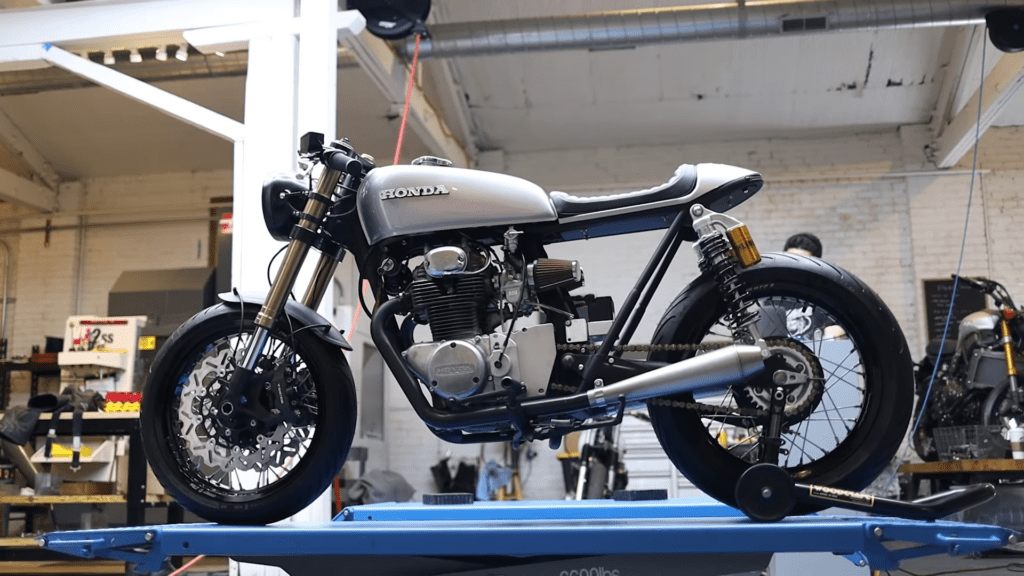
Now that we’ve covered the history of the Honda CB350, let’s look at the key features and specs that make this bike a popular choice for everyday riders and custom builders. The CB350 has a strong foundation and is a great platform for turning into a cafe racer. Whether you’re riding the original CB350 Twin from the 1960s or the modern Honda H’ness CB350, the core qualities of these bikes make them both flexible and fun to ride.
Engine and Performance
At the core of the Honda CB350 is its 325cc parallel-twin engine. In its original form, this engine makes 36 horsepower, which might seem small by today’s standards, but in the late 1960s, it was very competitive for a light motorcycle. It’s not just about horsepower, though. The engine is known for being reliable, fuel-efficient, and easy to maintain. This made the CB350 a favorite for both beginners and experienced riders.
When Honda launched the Honda H’ness CB350 in 2020, they updated the engine to a 348cc single-cylinder, producing 21 PS and 29.4 Nm of torque. While these numbers are lower than the original twin-cylinder, the H’ness CB350 is designed more for comfort and style than raw power. It’s great for riding through city streets or enjoying a relaxed weekend ride.
One of the best features of the CB350 engine, in both its old and new forms, is its smooth power delivery. The bike speeds up steadily, making it easy to control, even for new riders. This is why the CB350 became a top choice for builders wanting to create a reliable cafe racer. The engine’s compact size and simple design make it easy to modify, whether you want to upgrade the carburetor, exhaust system, or any other performance part.
Chassis and Build Quality
One of the reasons the Honda CB350 is such a great choice for cafe racer builds is its lightweight frame. The CB350 uses a double-cradle chassis, which gives both stability and flexibility. This makes the bike quick and easy to handle in corners and comfortable for city riding. Its low weight also means you can strip it down to just the basics, which is perfect when turning it into a cafe racer.
The modern Honda H’ness CB350 keeps this lightweight frame but adds a bit more bulk to include modern features like ABS and disc brakes. However, it still keeps the simple design of the original, making it a great choice for anyone wanting to build a cafe racer with a modern twist.
Styling and Design Features
Styling is one of the most important parts of any cafe racer, and the Honda CB350 has all the right features to make it a classic. The original CB350 had a clean, simple design with a round headlight, a teardrop-shaped fuel tank, and a low seat height. This timeless look makes the CB350 a great canvas for custom builders.
Many custom builds add a single-seat cowl to give the bike that classic cafe racer style, often paired with clip-on handlebars for a more aggressive riding position. The original CB350 also has spoked wheels, which add to its vintage feel. Builders usually keep these spoked wheels or upgrade them with modern materials to improve both the look and performance.
The modern Honda H’ness CB350 takes cues from the original but adds some modern touches. The retro-styled chrome fenders, LED lights, and digital display make the H’ness CB350 a beautiful mix of old and new. Many customizers like this model because it offers the reliability and features of a modern bike while still allowing for that classic cafe racer style.
Braking and Suspension
The original Honda CB350 came with drum brakes on both the front and rear, which was common for bikes of that time. While they worked well, they don’t offer the stopping power that modern riders expect. Most custom builds upgrade to disc brakes for better performance, especially when riding at higher speeds or in more aggressive conditions.
The suspension on the original CB350 includes telescopic front forks and dual rear shocks. While this was enough for the era, many custom builders upgrade the suspension for a smoother ride, especially if the bike will be used in tougher conditions.
The Honda H’ness CB350 comes with ABS and a modern braking system, making it safer and more comfortable to ride right out of the box. Its suspension includes 41mm telescopic front forks and twin rear shock absorbers, offering a good balance of comfort and handling for most riders.
Popular Custom Builds of the Honda CB350
The Honda CB350 has been a favorite platform for custom motorcycle builds, especially in the cafe racer world. Its lightweight frame, simple design, and reliable engine make it a great base for customization. From hobby builders in their garages to professional customizers, the CB350 has been turned into amazing pieces that truly capture the spirit of the cafe racer. Let’s look at some of the most iconic custom builds and see what makes them stand out.
Highlight Key Builds
One of the most interesting things about the Honda CB350 is the wide range of custom builds out there. Every builder adds their own vision to the bike, creating something that shows both personal style and classic cafe racer elements. Below are some of the most notable Honda CB350 cafe racer builds:
1. Father-Daughter Custom: Honda CB350 by David & Sonya Lloyd
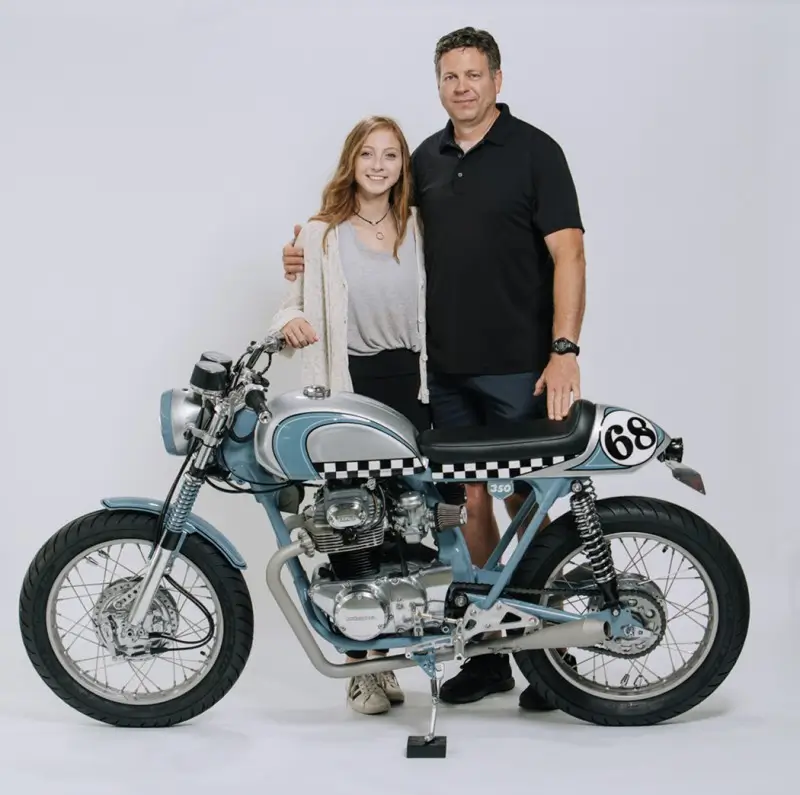
This custom build is a great example of how motorcycles can bring people together. David and his daughter Sonya created a stunning cafe racer from a 1970 Honda CB350 Twin, giving it a complete makeover. The build features clip-on handlebars, a custom single-seat cowl, and a clean, simple design that stays true to the cafe racer style. The details, like the custom exhaust and the beautifully finished fuel tank, really make this build stand out.
This project shows how the Honda CB350 can be a family effort, highlighting both craftsmanship and the joy of working together on a classic bike. It focuses on simplicity and performance, which are key parts of a great cafe racer.
2. Honda CB350 Restomod by Merlin Cycleworks
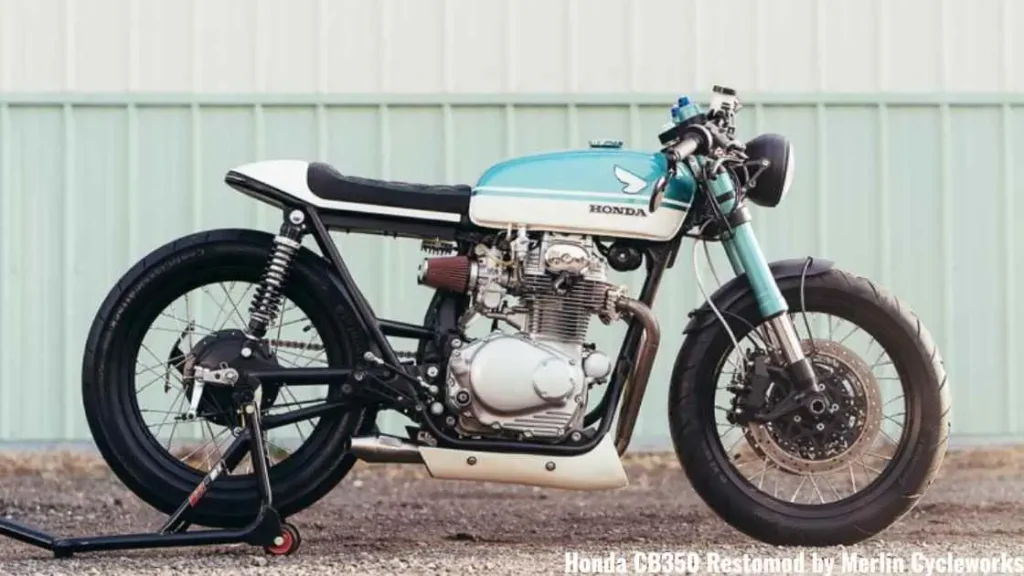
One of the most visually stunning Honda CB350 cafe racers is the restomod by Merlin Cycleworks. A restomod, which blends restoration with modernization, is a popular choice for builders who want to keep the classic look while upgrading the bike’s performance. This build kept the original parallel-twin engine but added modern features like LED lighting, upgraded suspension, and high-performance brakes.
The custom fuel tank was hand-crafted to keep the sleek lines of a traditional cafe racer, while the seat and tail section were completely redesigned for a more aggressive look. Merlin Cycleworks focused on improving the handling, braking, and overall comfort, turning the CB350 into a modern performer while keeping its vintage charm.
3. Shawn Lin’s CB350 Cafe Racer
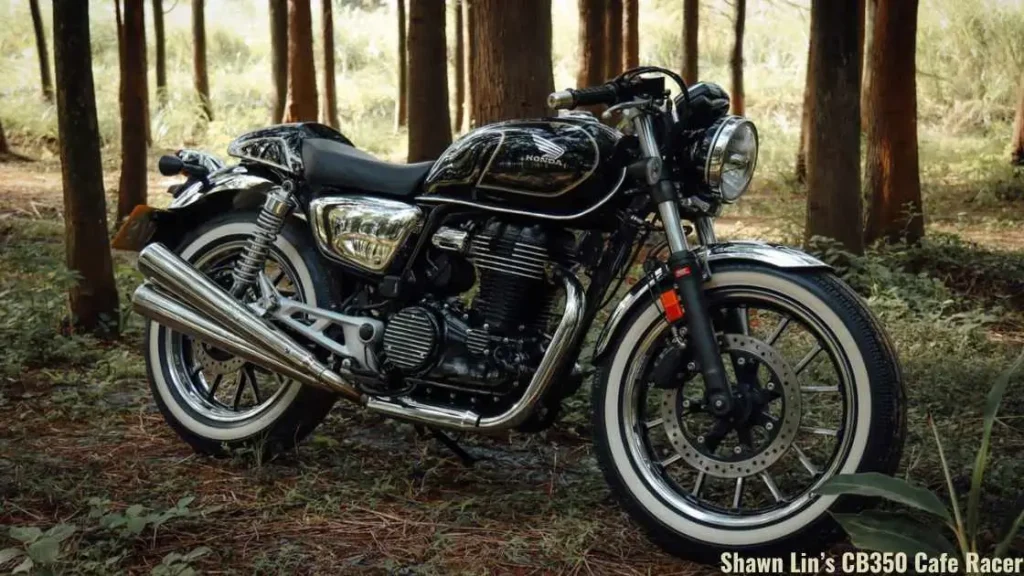
Shawn Lin, a concept artist with a passion for retro motorcycles, transformed his modern Honda H’ness CB350 into a piece of art. His approach was different because he used digital tools to design the bike before making any physical changes. This method let him carefully plan every part of the build, from the custom exhaust system to the eye-catching fairing.
One of the standout features of Shawn’s build is the wasp-tail hump that covers the rear part of the seat, giving the bike a more aerodynamic look. He also replaced the stock handlebars with clip-ons, creating the aggressive riding position typical of cafe racers. The custom-built exhaust system was designed to resemble the iconic four-into-four pipes of the Honda CB750, adding style and improving performance. This build shows how modern techniques and vintage inspiration can come together to create a truly unique motorcycle.
Key Elements in Custom CB350 Cafe Racers
Whether it’s a professional build or a garage project, certain key elements define a Honda CB350 cafe racer:
- Clip-On Handlebars: One of the most common changes, clip-on bars lower the rider’s position for a more aggressive stance, which is a signature feature of cafe racers.
- Single-Seat Cowl: Cafe racers usually have a solo seat with a cowl at the rear, giving the bike a streamlined and sporty look.
- Custom Exhaust Systems: Builders often swap the stock exhaust for a two-into-one or four-into-four system. This not only improves the bike’s appearance but also enhances performance and sound.
- Minimalist Design: Stripping the bike down to its bare essentials, removing unnecessary parts like large fenders, reduces weight and highlights the clean lines that define the cafe racer style.
- Upgraded Suspension and Brakes: Many builds add modern suspension and disc brakes to improve handling and safety, especially if the bike will be pushed hard on city streets or twisty roads.
Modifications and Customization Ideas for a Honda CB350 Cafe Racer
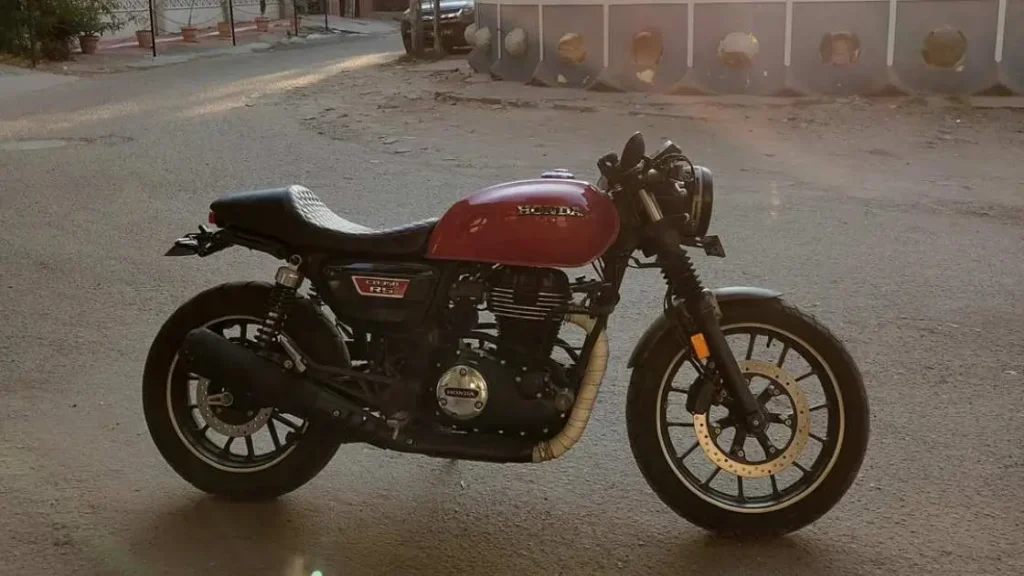
When it comes to turning a Honda CB350 into a true cafe racer, the options for modifications are endless. This section highlights the most popular and effective ways to customize your CB350, improving both its performance and looks. Whether you’re an experienced builder or someone taking on their first project, these customization ideas will help turn your Honda CB350 into a fast, stylish, and sleek cafe racer.
Engine Modifications
One of the first areas custom builders like to focus on is the engine. While the stock 325cc parallel-twin engine on the CB350 is reliable and efficient, there are several ways to boost its performance, making it better suited for cafe racer enthusiasts who want more speed and responsiveness.
- Exhaust Upgrades: A common modification is replacing the stock exhaust with a custom system. Many builders choose a two-into-one exhaust, which not only improves the bike’s look but also gives it a deeper, more powerful sound. A well-designed exhaust can also increase power by helping the engine breathe more easily, improving throttle response and adding a slight performance boost.
- Carburetor Tuning and Upgrades: Another popular engine upgrade is tuning or replacing the carburetors. While the stock carbs can be adjusted to run richer or leaner depending on the builder’s goals, many opt for more modern, high-performance carbs like Mikuni units. This can improve throttle response, acceleration, and overall engine efficiency.
- Air Filters: Many builders swap out the stock airbox for individual pod filters. Not only do these filters look sleek, but they also help increase airflow to the engine. This improves performance, especially when combined with a tuned carburetor and exhaust system.
- Ignition System: Upgrading from points to an electronic ignition can make a big difference in reliability and starting ease. Electronic ignitions provide a more consistent spark and reduce the maintenance that comes with traditional points ignition systems.
Aesthetic Changes
A big part of the cafe racer’s appeal is its minimalist, aggressive look. Builders usually focus on stripping the bike down to its essentials while adding custom touches to enhance its style and vibe.
- Clip-On Handlebars: One of the defining features of a cafe racer is the low, forward-leaning riding position, achieved by using clip-on handlebars. These not only change how the bike feels to ride but also give it the signature racing stance.
- Single-Seat Cowl: Another classic modification is adding a single-seat cowl. Cafe racers usually have a solo seat, with a raised cowl at the back to give the bike a sleeker, sportier look. Many custom builders create their own seat cowls to match the lines of the fuel tank and the bike’s overall style.
- Fuel Tank Modifications: The fuel tank is often modified or swapped out for a different one. A more angular or rounded tank can completely change the bike’s appearance. Many builders repaint or re-chrome the tank to add a personal touch. Adding pinstriping or vintage Honda winged emblems can boost the bike’s retro feel.
Performance Enhancements
For those looking to not only improve the look of their CB350 but also enhance its handling and ride quality, performance modifications are key. Here’s how you can make your CB350 perform as well as it looks:
- Suspension Upgrades: The stock telescopic forks on the CB350 are fine for casual riding but might feel outdated or too soft for more aggressive riding. Many builders upgrade the suspension by adding progressive fork springs or swapping out the front end with modern forks from a sportbike. The rear suspension can also be improved with adjustable shocks, allowing the rider to fine-tune the bike for either comfort or performance.
- Rear-Set Foot Controls: To improve the riding position, many custom cafe racers use rear-set foot controls. These move the footpegs further back, letting the rider tuck their legs in closer to the bike for a more aerodynamic, race-ready stance.
- Braking Upgrades: The stock drum brakes on the CB350 can be replaced with modern disc brakes for better stopping power. Builders often upgrade the front brake to a disc setup for more reliable and responsive braking, especially for a cafe racer built for higher speeds.
Electrical and Lighting Modifications
Another area where you can modernize the CB350 is the electrical system. Adding modern lighting and electronics can make the bike safer and more functional without losing its vintage charm.
- LED Lighting: Many custom builds use LED headlights, tail lights, and turn signals. LEDs not only offer better visibility but also reduce power consumption, which is important for older bikes with limited electrical output.
- Simplified Wiring: Builders often create a simplified wiring harness for cafe racers, removing unnecessary parts and rerouting wires for a cleaner, more minimal look. This can also boost reliability by reducing the number of connections that could fail.
- Modern Instruments: While some builders keep the stock speedometer and tachometer for their vintage appeal, others upgrade to aftermarket digital instruments. These provide more accurate readings while keeping a minimalist appearance.
Cost of Modifications
One of the major factors to think about when modifying a Honda CB350 is the cost. Depending on your goals, you could spend anywhere from a few hundred dollars on basic mods to several thousand on a full custom build. It’s important to plan your modifications based on both your budget and your overall vision for the cafe racer.
- Basic Mods (clip-ons, seat cowl, exhaust) – $500 to $1,500
- Performance Upgrades (carb tuning, suspension, brakes) – $1,000 to $3,000
- Full Custom Build (engine work, complete aesthetic overhaul, new parts) – $3,000 and up
Comparing the Honda CB350 to Other Cafe Racers
In the world of cafe racers, the Honda CB350 stands out as one of the most loved platforms for customization. However, it’s not the only bike that builders and enthusiasts admire. There are several other motorcycles in this category, each offering unique strengths and features. Let’s see how the Honda CB350 compares to other popular cafe racer platforms, focusing on performance, design, and customization potential.
Honda CB350 vs. Honda CB360
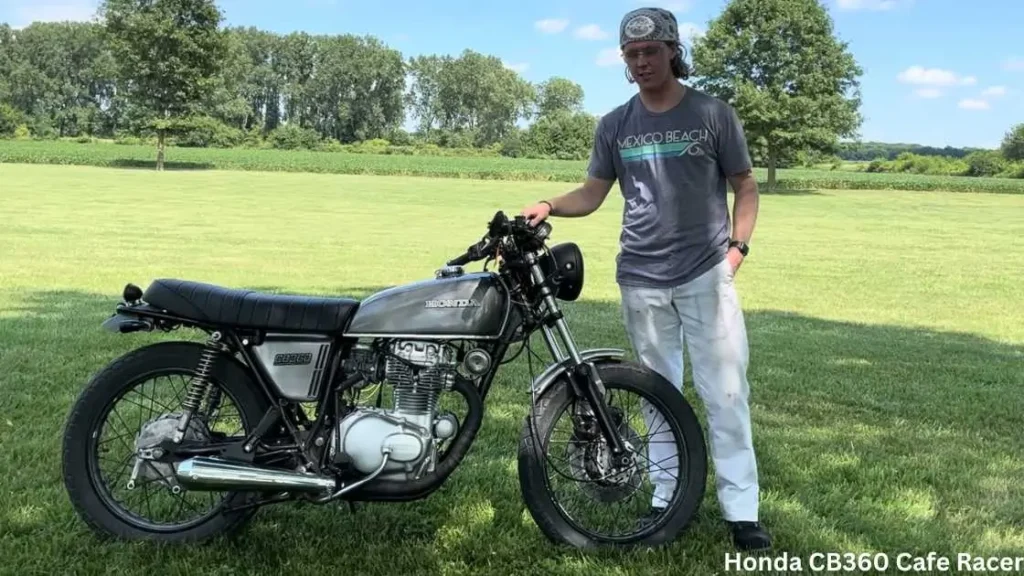
The Honda CB360 was introduced as the successor to the CB350 in the mid-1970s. While they are similar in appearance and performance, there are key differences that set them apart.
- Engine: The CB350 has a 325cc parallel-twin engine producing 36 horsepower, while the CB360 comes with a 356cc engine that offers a bit more torque. However, many riders find the CB350 engine more reliable and smoother, making it a more popular choice for custom cafe racers.
- Handling and Frame: Both bikes have a similar double-cradle frame, but the CB350 is slightly lighter, giving it more agility, especially when modified for racing. The CB360 has slightly better suspension, making it more comfortable for longer rides, but it’s often passed over in favor of the more classic CB350 look.
- Customization Potential: The CB350 is generally preferred by custom builders because of the wide availability of aftermarket parts and its iconic cafe racer heritage. While the CB360 can also be turned into a great cafe racer, it doesn’t have the same following or historical appeal as the CB350.
Honda CB350 vs. Honda CB450
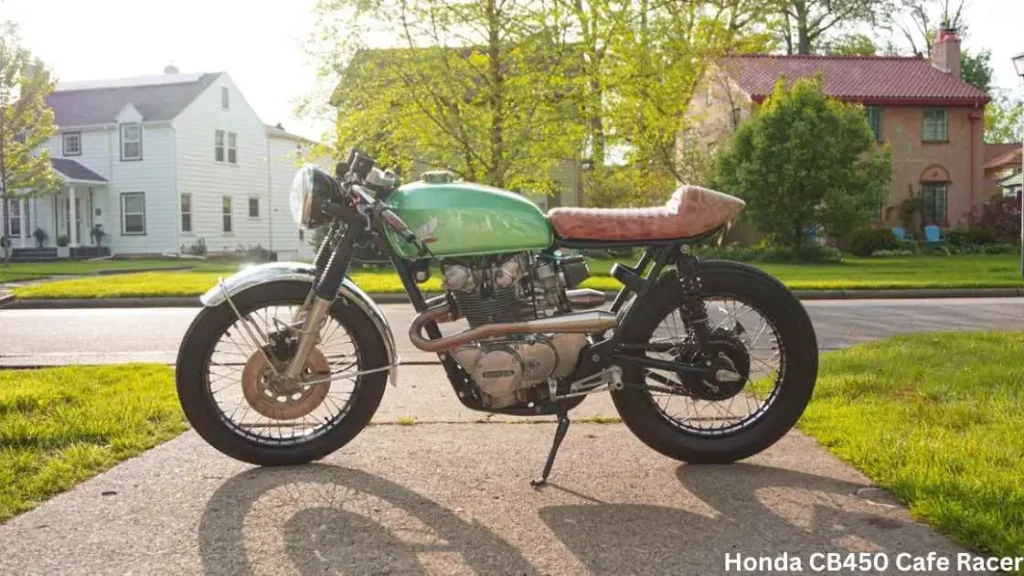
The Honda CB450 is another strong contender in the cafe racer scene, often picked for its 450cc parallel-twin engine, which offers more power than the CB350. It’s a favorite for riders who want more speed and acceleration in their custom builds.
- Power and Performance: The CB450 delivers a significant boost in power over the CB350, with an engine that produces around 45 horsepower compared to the CB350’s 36 horsepower. This extra power is great for riders planning to use their cafe racer for more than just short city rides.
- Handling: The CB450 is heavier than the CB350, which can make it less nimble and harder to handle for beginners. However, its extra weight adds stability at higher speeds, something some riders prefer.
- Aesthetics: When it comes to looks, the CB450 shares many of the same design features as the CB350. But it’s slightly larger frame and engine can make it appear bulkier. For those wanting a sleeker, more stripped-down look, the CB350 is usually the better choice.
Why Does the Honda CB350 Stand Out?
While many bikes can be turned into great cafe racers, the Honda CB350 continues to stand out for several reasons:
- Simplicity: The CB350’s simple design makes it a great platform for both beginners and experienced builders. It’s easy to work on, with a large aftermarket of parts available for customization.
- Reliability: Whether you’re riding the original 1960s model or the modern Honda H’ness CB350, the CB350 is known for being reliable, easy to maintain, and fun to ride.
- Customization Potential: The Honda CB350 is one of the most iconic bikes in the custom motorcycle scene. Its classic design, lightweight frame, and dependable engine make it a perfect base for all kinds of modifications, from small cosmetic tweaks to major performance upgrades.
In the end, while other bikes like the CB450, XS650, and Continental GT may offer more power or modern features, the Honda CB350 remains a favorite for those who want a bike that’s easy to customize, fun to ride, and deeply connected to cafe racer history.
Riding Experience and Ergonomics
One of the key aspects of any motorcycle is how it feels to ride, and the Honda CB350 Cafe Racer offers a unique mix of comfort, control, and style. The bike is small and lightweight, making it perfect for city riding, but it’s also versatile enough to handle longer rides on highways or twisty roads. Let’s take a closer look at the riding experience and how the bike’s ergonomics make it a popular choice among cafe racer enthusiasts.
Rider Position and Comfort
One of the biggest changes when converting a standard Honda CB350 into a cafe racer is the rider’s position. Cafe racers are known for their low, forward-leaning stance, achieved mainly by using clip-on handlebars and rear-set foot controls. These changes put the rider in a more aerodynamic position, perfect for short bursts of speed and sporty riding.
However, this aggressive posture can be uncomfortable for long-distance rides, especially if you’re not used to it. The clip-on handlebars make the rider lean forward, putting more weight on the wrists and shoulders. At the same time, the rear-set foot controls push your legs back, which can lead to cramped knees on longer rides. For casual city riding or short weekend trips, this setup is great, but for longer journeys, it may feel tiring.
That said, many custom builders find ways to balance style and comfort. Some cafe racers are fitted with slightly raised clubman handlebars, offering a more upright position without losing the cafe racer look. Also, modern seat padding can help ease the discomfort of a traditional single-seat cowl, making it more practical for everyday use.
Handling on the Road
The Honda CB350 is known for its light and nimble handling, which is one reason it became such a popular platform for cafe racers. The bike’s double-cradle frame provides a solid base, and with suspension and brake upgrades, it offers a riding experience that’s both responsive and fun.
On city streets, the CB350 feels quick and agile, making it easy to weave through traffic. Its lightweight frame makes cornering smooth, and the bike’s small size allows it to handle tight spaces and narrow roads with confidence. The cafe racer stance adds to this by putting the rider in a position that feels more connected to the bike and the road.
For more aggressive riding on twisty roads or highways, many custom CB350 cafe racers feature upgraded suspension. While the stock suspension is fine for casual riding, those looking for a smoother ride or better handling often add modern adjustable shocks and upgrade the fork springs. These changes help the bike handle bumps and corners with more control, giving the rider confidence to push the bike harder.
Ergonomic Considerations for Daily Riding vs. Racing
One of the key things to consider when building a cafe racer from a Honda CB350 is finding the right balance between style and comfort. While the cafe racer look is focused on speed and performance, most riders will be using their bikes for daily commutes or weekend cruising, not actual racing. So, the bike needs to be comfortable enough for everyday riding while still keeping that classic cafe racer style.
Some riders stick with rear-set foot controls but choose a more padded seat or slightly higher handlebars to make the bike more comfortable for longer rides. Others add bar-end mirrors for better visibility or upgrade the headlight and tail light to LED for better night riding.
Overall, the Honda CB350 cafe racer offers a great balance of style and practicality. While the traditional cafe racer setup might not be ideal for long-distance trips, it’s perfect for short, fun rides around town or on twisty backroads.
Maintenance and Care for a Honda CB350 Cafe Racer
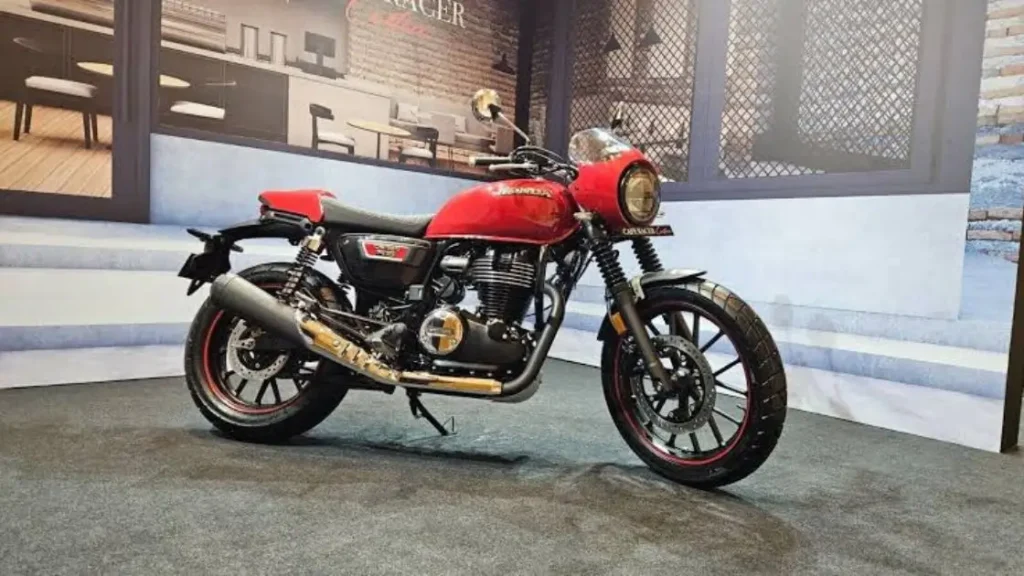
Like any vintage motorcycle, the Honda CB350 Cafe Racer needs regular maintenance to keep it running smoothly and looking sharp. One reason the CB350 became so popular in the 1960s and 70s was its reputation for reliability and easy maintenance. However, as a vintage bike or a modified cafe racer, it comes with some unique challenges. Here’s what you’ll need to do to keep your CB350 cafe racer in top condition, covering both routine care and tips for sourcing parts.
Routine Maintenance Tips
Keeping your Honda CB350 in good shape requires regular checks and maintenance. Below are the basic tasks every CB350 owner should know:
- Oil Changes: Regular oil changes are crucial for keeping the engine healthy. Most experts recommend changing the oil every 1,500 to 2,000 miles or at least once a year if you don’t ride as often. Use high-quality motorcycle oil to ensure proper lubrication, especially for a vintage bike where parts might show wear.
- Chain Maintenance: The chain needs to be cleaned and lubricated regularly, particularly if you’re riding in dirty or wet conditions. Check the chain tension and adjust it as needed to ensure smooth power delivery and prevent excess wear.
- Brakes: If your bike still has its original drum brakes, regularly check the brake shoes for wear. Drum brakes need more attention than modern disc brakes, so make sure they’re properly adjusted. If your cafe racer has been upgraded to disc brakes, keep an eye on the brake pads and fluid levels.
- Carburetor Tuning: The carburetors are key to the bike’s performance. Over time, they can get clogged or fall out of sync, affecting performance. Cleaning and syncing the carbs every 3,000 miles or so is recommended, especially after storage periods.
- Battery Check: Older bikes like the CB350 may have weaker electrical systems. Regularly check the battery, clean the terminals, and keep it charged. Upgrading to a modern lithium battery can provide better reliability and reduce weight.
By staying on top of these tasks, you’ll keep your Honda CB350 Cafe Racer running at its best.
Vintage Parts Availability
Finding parts for the Honda CB350 isn’t as difficult as it might seem. Since the CB350 was one of Honda’s most popular models and remains popular in the custom bike scene, there’s a wide range of aftermarket parts still available.
- Online Marketplaces: Websites like eBay, Craigslist, and specialized forums often have a wide selection of both OEM and aftermarket parts. You can find everything from engine components to bodywork.
- Specialty Shops: Several custom bike shops and online retailers specialize in vintage Honda parts. Shops like Dime City Cycles and Revival Cycles often carry parts specifically for CB350 cafe racers, including custom exhausts and modern brake kits.
These resources make it easier to keep your CB350 cafe racer running and looking great.
DIY vs. Professional Maintenance
One of the advantages of owning a Honda CB350 is that it’s relatively easy to work on, especially compared to more modern, complex motorcycles. Many cafe racer enthusiasts enjoy doing their own maintenance, which can save money and give you a better understanding of your bike. Here are some tasks you can handle yourself:
- Oil changes and filter replacement.
- Chain cleaning and adjusting the tension.
- Basic carburetor tuning if you have the right tools.
- Replacing worn parts like brake shoes, cables, or even swapping out the exhaust system.
For more complex tasks, like engine rebuilds or major electrical repairs, it might be best to consult a professional, especially if you’re new to motorcycle maintenance. Vintage engines can be tricky, and one mistake could lead to bigger problems later.
Seasonal Maintenance and Storage
If you live in an area with harsh winters, storing your Honda CB350 properly during the off-season is key to keeping it in good shape. Here are a few tips:
- Fuel System: Add fuel stabilizer to the gas tank to keep the fuel from degrading. This helps prevent the carburetors from getting clogged.
- Battery: Disconnect the battery and store it in a cool, dry place. Use a trickle charger to keep it maintained over the winter.
- Tires: Inflate your tires to the recommended pressure. If possible, keep the bike on a stand to prevent flat spots from forming.
- Cover: Use a proper motorcycle cover to protect the bike from dust and moisture. If you can, store it in a garage or shed to shield it from the elements.
Following these steps will help ensure your CB350 is ready to ride when spring arrives.
Upgrading vs. Maintaining Original Parts
One of the key decisions you’ll face as a Honda CB350 cafe racer owner is whether to keep the original parts or upgrade to modern alternatives. Both choices have their pros and cons:
- Maintaining Original Parts: Keeping the bike in its original condition adds to its vintage charm and helps maintain its value as a classic. However, older parts can be harder to find and may need more frequent maintenance.
- Upgrading to Modern Parts: Modern components like LED lighting, electronic ignition systems, and disc brakes can improve your bike’s performance, reliability, and safety. These upgrades make it easier for daily use and reduce the amount of maintenance required.
It ultimately depends on how you plan to use your bike. If you want to ride your CB350 cafe racer regularly, upgrading to modern parts might be the better option. But if your focus is on preserving the bike’s original design, sticking to vintage parts will help keep its authenticity.
Where to Buy or Customize a Honda CB350?
Whether you’re looking to buy a Honda CB350 for the first time or seeking custom shops to bring your cafe racer vision to life, knowing where to find parts and services is key. In this section, we’ll guide you through some of the best places to buy a Honda CB350, whether you’re after a project bike or a fully customized cafe racer. We’ll also explore options for finding skilled builders and specialty shops that can help turn your CB350 into the cafe racer of your dreams.
- Where to Buy a CB350: You can often find Honda CB350s on online marketplaces like eBay, Craigslist, or vintage motorcycle forums. These platforms are great for both project bikes and fully restored models, depending on your budget and plans.
- Skilled Builders and Custom Shops: If you’re looking for a professional to build or customize your bike, shops like Dime City Cycles, Revival Cycles, and other custom motorcycle builders specialize in turning CB350s into stunning cafe racers. These shops often offer both parts and complete builds, allowing you to get everything you need in one place.
By knowing where to look, you can easily find the right bike and builders to make your cafe racer dreams a reality.
Expected Costs for a Custom Honda CB350
Buying and customizing a Honda CB350 can come with a wide range of costs, depending on whether you’re buying a stock bike and modifying it yourself or hiring a shop to handle the entire build. Here’s what you can expect:
- Purchasing a Honda CB350: Prices for an original, unmodified CB350 vary based on its condition. A project bike in rough shape may cost between $1,000 and $2,500, while a fully restored CB350 can range from $3,000 to $6,000.
- Basic Custom Modifications: If you’re starting with a stock CB350 and want to add cafe racer elements like clip-on handlebars, rear-set foot controls, and a single-seat cowl, you can expect to spend between $1,000 and $2,500 on parts and labor, depending on whether you do the work yourself or hire a professional.
- Complete Custom Build: For a full custom build from a professional shop like Kott Motorcycles or Revival Cycles, costs can range from $5,000 to $15,000 or more. This reflects not only the labor but also high-end parts and custom fabrication that go into creating a one-of-a-kind motorcycle.
Where to Find Custom Parts for Honda CB350 Cafe Racers?
Whether you’re working on your bike yourself or looking for unique parts for a professional build, having access to reliable parts suppliers is essential. Here are some of the best places to find parts for your Honda CB350 cafe racer:
- eBay Motors: A great resource for both new and used parts. You can find OEM replacements, custom-made parts, and aftermarket upgrades, often at competitive prices.
- Partzilla: This site offers a vast catalog of OEM parts for vintage motorcycles, including the Honda CB350. If you’re looking to restore your CB350 with original parts, this is a great place to start.
- Common Motor Collective: Specializing in parts for vintage Honda motorcycles, Common Motor Collective is an excellent source for CB350 parts. They offer everything from engine rebuild kits to electrical components, and they also provide helpful tutorials for DIY builders.
These suppliers will help you find the parts you need to keep your CB350 cafe racer running and looking its best.
Why the Honda CB350 is the Ideal Choice for Cafe Racer Builds?
The Honda CB350 remains one of the most popular platforms for building custom cafe racers, thanks to its timeless design, reliability, and ease of modification. Its blend of vintage aesthetics and customization potential has kept it at the forefront of the cafe racer scene, appealing to both seasoned builders and newcomers alike.
The CB350’s simple yet durable construction allows for a wide range of modifications, from performance upgrades to aesthetic changes, making it versatile for different riding styles and preferences. Whether you want to keep its classic charm or add modern touches, the availability of parts and the wealth of community knowledge surrounding this model make it a rewarding project bike.
For those looking for a reliable, affordable, and stylish motorcycle that can be transformed into a unique cafe racer, the Honda CB350 is one of the best choices. Its rich history in the custom motorcycle world, combined with the joy it brings on the road, makes it more than just a bike—it’s an experience.
This motorcycle represents a perfect blend of history and customization potential, showing that a Honda CB350 Cafe Racer is more than just a project; it’s a gateway into the world of classic motorcycles, creativity, and personal expression. Whether you’re restoring it or going for a full custom build, the CB350 will continue to inspire and excite riders and builders alike.
Disclaimer:
The information provided in this article is intended for general informational and educational purposes only. While every effort has been made to ensure the accuracy and reliability of the content, it should not be considered professional or expert advice. Modifying motorcycles, especially vintage models like the Honda CB350, involves mechanical skills, and we recommend consulting with a professional mechanic or custom bike shop before attempting any significant modifications or repairs.
Additionally, the products, services, or shops mentioned in this article are based on independent research and do not constitute endorsements or affiliations. Readers should verify the availability, legality, and suitability of any parts, modifications, or services mentioned, and perform due diligence when making any purchases.
We strive to provide accurate and up-to-date information, but we cannot be held responsible for any inaccuracies or changes that may occur. The reader assumes full responsibility for their actions and decisions based on the content provided.
FAQs
What makes the Honda CB350 a good platform for a cafe racer build?
The Honda CB350 is great for cafe racer builds because it has a light frame, a reliable 325cc twin engine, and a simple design that’s easy to work with. It’s well-known in the cafe racer scene, and there are lots of aftermarket parts available. Its classic style and affordability make it a favorite for both beginners and experienced builders.
What are the best modifications for a Honda CB350 cafe racer?
Some of the best mods for a Honda CB350 cafe racer include adding clip-on handlebars for a sportier feel, a single-seat cowl for a cleaner look, and upgrading the exhaust and carburetor to boost performance. You can also improve handling by upgrading the suspension and switching to disc brakes for better safety.
How reliable is the Honda CB350 for daily use as a cafe racer?
The Honda CB350 is known for being reliable, even though it’s a vintage bike. With regular care like oil changes, chain adjustments, and carb cleaning, it can be used daily. It’s also easy to fix, and parts are widely available. This makes it a good choice if you want a stylish, dependable cafe racer for everyday riding.
Where can I buy parts for customizing a Honda CB350 cafe racer?
You can find parts for a Honda CB350 cafe racer in many places online. Popular shops include Dime City Cycles, Revival Cycles, Common Motor Collective, and eBay Motors. These sites offer parts like clip-on bars, foot controls, custom exhausts, and performance upgrades like suspension kits and brakes.
How much does it cost to build a Honda CB350 cafe racer?
The cost of building a Honda CB350 cafe racer depends on how much you want to modify. A project bike usually costs $1,000 to $3,000, and basic mods like a new seat, handlebars, and exhaust may add another $1,000 to $2,500. A fully custom build by a shop could range from $5,000 to $15,000, depending on parts and labor.

